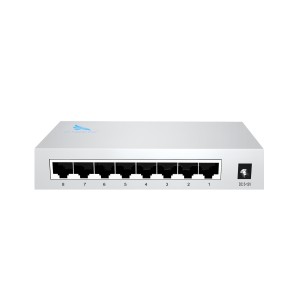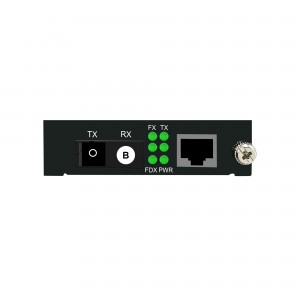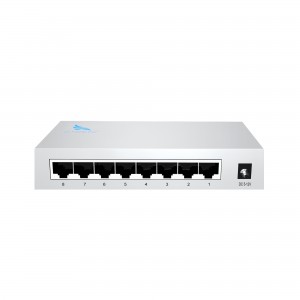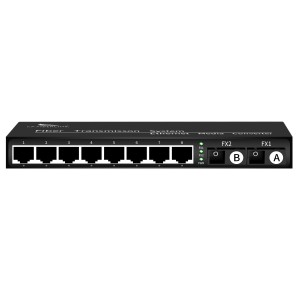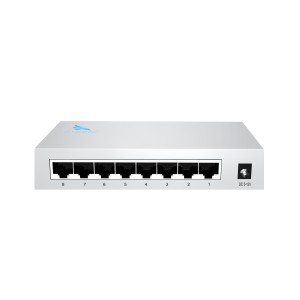8FE+2GE WDM Media Converter (multi-mode Dual-fiber SC)
8FE+2GE WDM Media Converter (multi-mode Dual-fiber SC)
Product Features:
Huizhou Changfei Optoelectronics Technology Co., Ltd. launched a revolutionary 100G fiber-to-serial converter
Are you tired of slow internet connections and unreliable network performance? Look no further, Huizhou Changfei Optoelectronics Technology Co., Ltd. has developed a cutting-edge solution to transform your web experience. Introducing our latest innovation – the 100 Gigabit 8 Optical 2 Electrical Multimode Dual Fiber Media Converter Housing.
Our products are designed to deliver lightning-fast data transfers, seamless connectivity and unrivaled performance. With its advanced features and state-of-the-art technology, this media converter enclosure is the ultimate solution for industries that require high-speed data transmission.
100 Gigabit 8 Optical 2 Electrical Multimode Dual Fiber Media Converter Chassis combines the best of both fiber optic and serial converters into one device. It seamlessly converts fiber optic signals to serial, making it ideal for businesses requiring Ethernet-to-fiber conversion. With this product, you can say goodbye to slow and unreliable connections and embrace the future of network communication.
The transceiver box supports 100G data transmission to ensure fast and efficient data transmission. With its 8 fiber ports and 2 electrical multimode dual fiber ports, you can easily connect multiple devices simultaneously, increasing the productivity and flexibility of your network infrastructure.
At Huizhou Changfei Optoelectronics Technology Co., Ltd., we understand the importance of reliable and secure network solutions. Our media converter enclosures offer IP30 protection to ensure protection from dust and other contaminants. Uninterrupted transmission is guaranteed even in challenging environments, making it suitable for a wide range of industries.
One of our top priorities is energy efficiency. Our products utilize low power external power supplies to minimize energy consumption and reduce operating costs. Huizhou Changfei Photoelectric Technology Co., Ltd. is committed to the sustainable development of the environment and developed this photoelectric converter chassis with energy-saving functions, making it an environmentally friendly choice.
The medium changer enclosure is easily configured and managed using a 4-digit dial code. This feature simplifies installation and reduces the time required for network deployment. We believe technology should be easy to use and user friendly, and the simple setup of our products reflects our commitment to providing hassle-free solutions.
Huizhou Changfei Photoelectric Technology Co., Ltd. is an industry-leading technology enterprise specializing in the design and manufacture of a series of communication equipment. We take pride in being able to provide the highest quality products and services backed by a dedicated team of professionals. The company focuses on innovation and pursuit of excellence, and has made significant contributions to the development of 5G communication equipment, core switches, fiber optic transceivers and other fields.
By choosing our 100 Gigabit 8 Optical 2 Electrical Multimode Dual Fiber Media Converter Chassis, you are investing in a reliable high performance networking solution. Upgrade your network infrastructure today and experience the power of seamless connectivity and fast data transfers.
Don’t settle for slow connections and limited bandwidth. Embrace the future with Huizhou Changfei Optoelectronics Technology Co., Ltd. and witness the transformation of your network capabilities. Contact us today and let our cutting-edge technology revolutionize your communication experience.
Technical Parameter:
| Model | CF-8F22GMW-2 | |
| Interface Characteristics | ||
| Fixed Port | 2* 10/ 100/ 1000Base-T RJ45 port
8* 155M uplink SC fiber port |
|
| Ethernet Port | 10/ 100/ 1000Base-T auto-sensing, full/half duplex MDI/MDI-X self-adaption | |
| Twisted Pair
Transmission |
10BASE-T: Cat3,4,5 UTP(≤100 meter)
100BASE-T: Cat5e or later UTP(≤100 meter) 1000BASE-T : Cat5e or later UTP(≤100 meter) |
|
| Optical Port | The default optical module is multimode dual fiber 2km, SC port | |
| Wavelength/Distance | multimode: 850nm 0~550M,1310nm 0~2KM | |
| Chip Parameter | ||
| Network Protocol | IEEE802.3 10BASE-T, IEEE802.3i 10Base-T,IEEE802.3u 100Base-TX, IEEE802.3u 100Base-FX, IEEE802.3x
IEEE802.3ab 1000Base-T;IEEE802.3z 1000Base-X; |
|
| Forwarding Mode | Store and Forward(Full Wire Speed) | |
| Switching Capacity | 5.6Gbps | |
| Buffer Memory | 4.16Mpps | |
| MAC | 2K | |
| LED Indicator | Fiber | FX1 (green)-FX8 (green) |
| On the RJ45 seat | 1X-2X Yellow:Indicate PoE | |
| 1X-2X Green: Indicates network working status | ||
| Power | PWR (green) | |
| Power | ||
| Working Voltage | AC:100-240V | |
| Power Consumption | Standby<3W, Full load<10W | |
| Power Supply | DC:5V/2A industrial power supply | |
| Lightning protection &Certification | ||
| Lightning protection | Lightning protection: 4KV 8/20us, Protection level: IP30 | |
| Certification | CCC;CE mark, commercial; CE/LVD EN60950;FCC Part 15 Class B; RoHS | |
| Physical Parameter | ||
| Operation TEMP | -20~+55°C;5%~90% RH Non condensing | |
| Storage TEMP | -40~+85°C;5%~95% RH Non condensing | |
| Dimension (L*W*H) | 220mm* 101mm*28mm | |
| Installation | Desktop | |
Product Size:
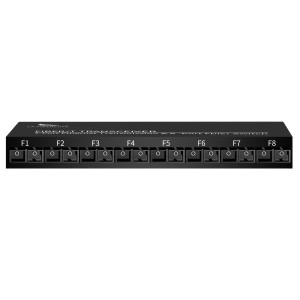
product application diagra:

How to choose a fiber optic transceiver?
Optical fiber transceivers break the 100-meter limitation of Ethernet cables in data transmission. Relying on high-performance switching chips and large-capacity caches, while truly achieving non-blocking transmission and switching performance, they also provide balanced traffic, isolation and conflict. Error detection and other functions ensure high security and stability during data transmission. Therefore, fiber optic transceiver products will still be an indispensable part of actual network construction for a long time. So, how should we choose fiber optic transceivers?
1. Port function test
Mainly test whether each port can work normally in the duplex state of 10Mbps, 100Mbps and half-duplex state. At the same time, it should be tested whether each port can automatically select the highest transmission speed and automatically match the transmission rate of other devices. This test can be included in other tests.
2. Compatibility test
It mainly tests the connection ability between the optical fiber transceiver and other devices compatible with Ethernet and Fast Ethernet (including network card, HUB, Switch, optical network card, and optical switch). The requirement must be able to support the connection of compatible products.
3. Cable connection characteristics
Test the fiber optic transceiver’s ability to support network cables. First, test the connection ability of Category 5 network cables with lengths of 100m and 10m, and test the connection ability of long Category 5 network cables (120m) of different brands. During the test, the optical port of the transceiver is required to have a connection capability of 10Mbps and a rate of 100Mbps, and the highest must be able to connect to a full-duplex 100Mbps without transmission errors. Category 3 twisted pair cables may not be tested. Subtests can be included in other tests.
4. Transmission characteristics (transmission loss rate of data packets of different lengths, transmission speed)
It mainly tests the packet loss rate when the optical fiber transceiver optical port transmits different data packets, and the connection speed under different connection rates. For the packet loss rate, you can use the test software provided by the network card to test the packet loss rate when the packet size is 64, 512, 1518, 128 (optional) and 1000 (optional) bytes under different connection rates. , the number of packet errors, the number of packets sent and received must be more than 2,000,000. Test transmission speed can use perform3, ping and other software.
5. The compatibility of the whole machine to the transmission network protocol
It mainly tests the compatibility of fiber optic transceivers to network protocols, which can be tested in Novell, Windows and other environments. The following low-level network protocols such as TCP/IP, IPX, NETBIOS, DHCP, etc. must be tested, and the protocols that need to be broadcast must be tested. Optical transceivers are required to support these protocols (VLAN, QOS, COS, etc.).
6. Indicator status test
Test whether the status of the indicator light is consistent with the description of the panel and the user manual, and whether it is consistent with the current status of the fiber optic transceiver.








